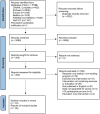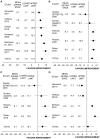Evaluation of the Structure and Health Impacts of Exercise-Based Cardiac and Pulmonary Rehabilitation and Prehabilitation for Individuals With Cancer: A Systematic Review and Meta-Analysis
- PMID: 34631836
- PMCID: PMC8494200
- DOI: 10.3389/fcvm.2021.739473
Evaluation of the Structure and Health Impacts of Exercise-Based Cardiac and Pulmonary Rehabilitation and Prehabilitation for Individuals With Cancer: A Systematic Review and Meta-Analysis
Abstract
Exercise-based, multimodal rehabilitation programming similar to that used in the existing models of cardiac or pulmonary rehabilitation or prehabilitation is a holistic potential solution to address the range of physical, psychological, and existential (e.g., as their diagnosis relates to potential death) stressors associated with a cancer diagnosis and subsequent treatment. The purpose of this study was to systematically evaluate the structure and format of any type of exercise-based, multimodal rehabilitation programs used in individuals with cancer and the evidence base for their real-world effectiveness on metrics of physical (e.g., cardiorespiratory fitness, blood pressure) and psychological (e.g., health-related quality of life) health. Very few of the 33 included exercise-based, multimodal rehabilitation programs employed intervention components, education topics, and program support staff that were multi-disciplinary or cancer-specific. In particular, a greater emphasis on nutrition care, and the evaluation and management of psychosocial distress and CVD risk factors, with cancer-specific adaptations, would broaden and maximize the holistic health benefits of exercise-based rehabilitation. Despite these opportunities for improvement, exercise-based, multimodal rehabilitation programs utilized under real-world settings in individuals with cancer produced clinically meaningful and large effect sizes for cardiorespiratory fitness (VO2peak, ±2.9 mL/kg/min, 95% CI = 2.6 to 3.3) and 6-minute walk distance (+47 meters, 95% CI = 23 to 71), and medium effect sizes for various measures of cancer-specific, health-related quality of life. However, there were no changes to blood pressure, body mass index, or lung function. Overall, these findings suggest that exercise-based, multimodal rehabilitation is a real-world therapy that improves physical and psychological health among individuals with cancer, but the holistic health benefits of this intervention would likely be enhanced by addressing nutrition, psychosocial concerns, and risk factor management through education and counselling with consideration of the needs of an individual with cancer.
Keywords: Pulmonary rehabilitation (PR); cancer; cardiac rehabilitation (CR); exercise training; multi-disciplinary; prehabilitation.
Copyright © 2021 Rickard, Eswaran, Small, Bonsignore, Pakosh, Oh and Kirkham.
Conflict of interest statement
The authors declare that the research was conducted in the absence of any commercial or financial relationships that could be construed as a potential conflict of interest.
Figures




References
-
- Balady GJ, Williams MA, Ades PA, Bittner V, Comoss P, Foody JAM, et al. . Core components of cardiac rehabilitation/secondary prevention programs: 2007 update - a scientific statement from the American heart association exercise, cardiac rehabilitation, and prevention committee, the council on clinical cardiology; the councils on cardiovascular nursing, epidemiology and prevention, and nutrition, physical activity, and metabolism; and the American association of cardiovascular and pulmonary rehabilitation. J Cardiopulm Rehabil Prev. (2007) 27:3. 10.1097/01.HCR.0000270696.01635.aa - DOI - PubMed
Publication types
LinkOut - more resources
Full Text Sources
Research Materials

